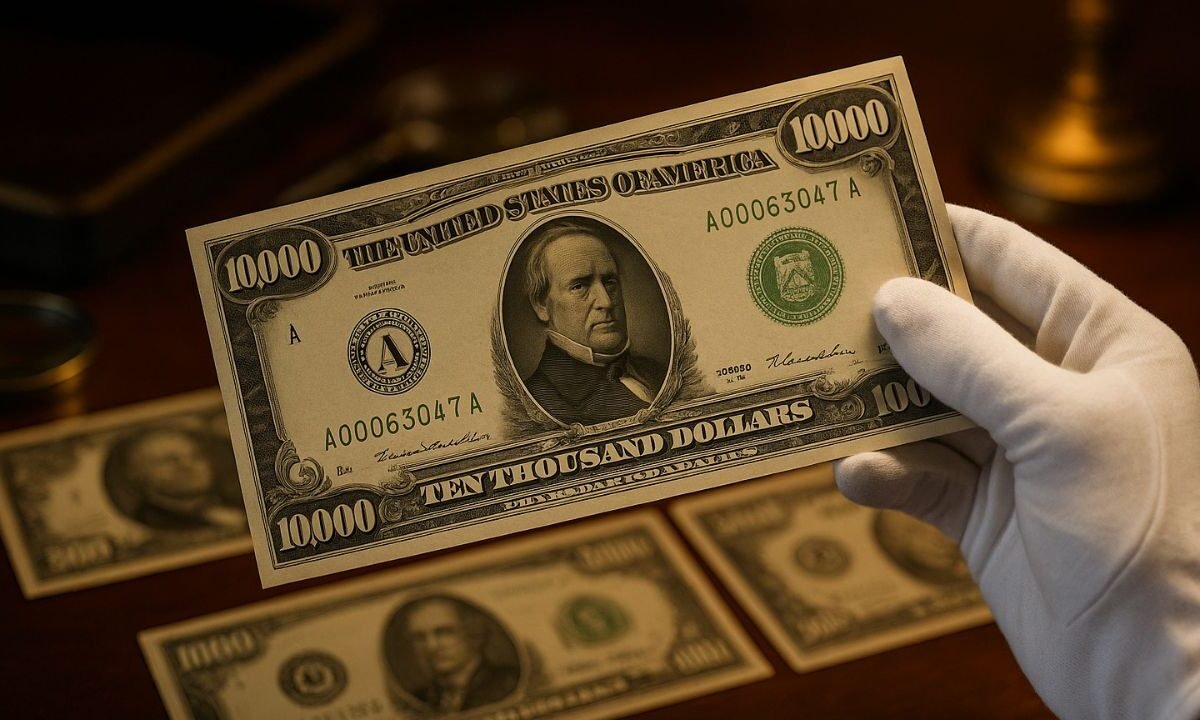The $500, $1,000, $5,000, and $10,000 bills were printed mainly for bank-to-bank transfers and were discontinued in 1969, but they remain legal tender and highly collectible today.
The $100,000 Gold Certificate (1934) was never issued to the public and cannot be owned privately.
Quick 2025 value snapshot
Typical values below assume problem-free notes; prices vary depending on series, district, signatures, star notes, and condition.
| Denomination | Portrait & Series (common small-size) | Legal status | Typical 2025 collector value (problem-free) | Notable recent auction result |
|---|---|---|---|---|
| $500 (1934/1934-A) | William McKinley | Legal tender (no longer issued) | ~$800–$2,200+ from Fine to Extremely Fine; higher for Uncirculated and star replacements | Circulation-grade examples commonly in this range, premium for top grade. |
| $1,000 (1928/1934) | Grover Cleveland or Woodrow Wilson (1934) | Legal tender | ~$1,200–$5,000+ depending on condition; star/low serials higher | Mid-grade star notes often fetch $6,000–$7,000+. |
| $5,000 (1928/1934) | James Madison | Legal tender | Scarce; five-figure values common for attractive condition notes | Record: roughly $780,000 for a premium example; others in $120k–$200k range. |
| $10,000 (1934) | Salmon P. Chase | Legal tender | Extremely scarce; six-figure territory typical for well-graded examples | Example: around $480,000 for a top-grade note. |
| $100,000 (1934 Gold Certificate) | Woodrow Wilson | Not legal for private ownership | N/A (non-collectible for private market) | Held by government/museum institutions only. |
What drives the value in 2025
- Condition (Grade): Improvement in grade from circulated to uncirculated can multiply value many times over. Professional grading provides benchmark reliability.
- Rarity by series/district/serial: The presence of star replacement notes, very low serial numbers, and scarce Federal Reserve district identifiers can add large premiums.
- Recent headline sales: Fresh record prices help elevate market expectations for similar items.
- Authenticity and originality: Notes that have original paper texture, bright crisp printing, no repairs or folds, and are untouched tend to command the highest prices.
How to evaluate your note
- Identify the series, district, and signatures (for example: “Series 1934 A”, district “Chicago G”), as that affects rarity.
- Examine the condition: look for folds, writing, pinholes, stains, edge-wear; the fewer the defects, the stronger the value.
- Check for special serials or star replacement versions; these tend to carry premiums.
- Compare to recent comparable sales of the same series/district/grade to estimate market value.
- Remember that while these notes are legal to own (for $500–$10,000 bills), their value is far above face value, so spending them at face value would be a major loss.
Key take-aways
In 2025, high-denomination U.S. bills remain a compelling collecting area. Even the formerly “common” $500 and $1,000 bills now often trade for thousands of dollars.
The rarer $5,000 and $10,000 notes are true investment-grade pieces, with values in the six-figure range for top condition examples.
The $100,000 note is off-limits to private collectors. If you find one of these in your possession: verify series, district, condition and rarity; then you may have a note that’s worth far more than its face value.
High-denomination bills—those $500, $1,000, $5,000, and $10,000 notes—are not just historical artifacts but vibrant collectibles with significant market value in 2025. While face values are striking, the real value lies in rarity, grade and provenance.
Even mid-grade examples command thousands of dollars, and top-tier notes can reach into the hundreds of thousands.
These notes are not just remnants of U.S. monetary history—they’re actively traded assets with real market stakes. If you own one, treat it like a rare collectible, not just old currency.
FAQs
Are $500 and $1,000 bills still legal to spend?
Yes — they remain legal tender. However, since their collectible value is far greater than face value, using them for purchases would be highly unwise.
What’s the most a $5,000 or $10,000 bill has sold for recently?
High-end auction results show $5,000 bills reaching roughly $780,000 and $10,000 bills around $480,000, depending on grade and provenance.
Can I own a $100,000 bill?
No — the $100,000 Gold Certificate was never circulated publicly and is designated for official government and museum holdings, not private ownership.

